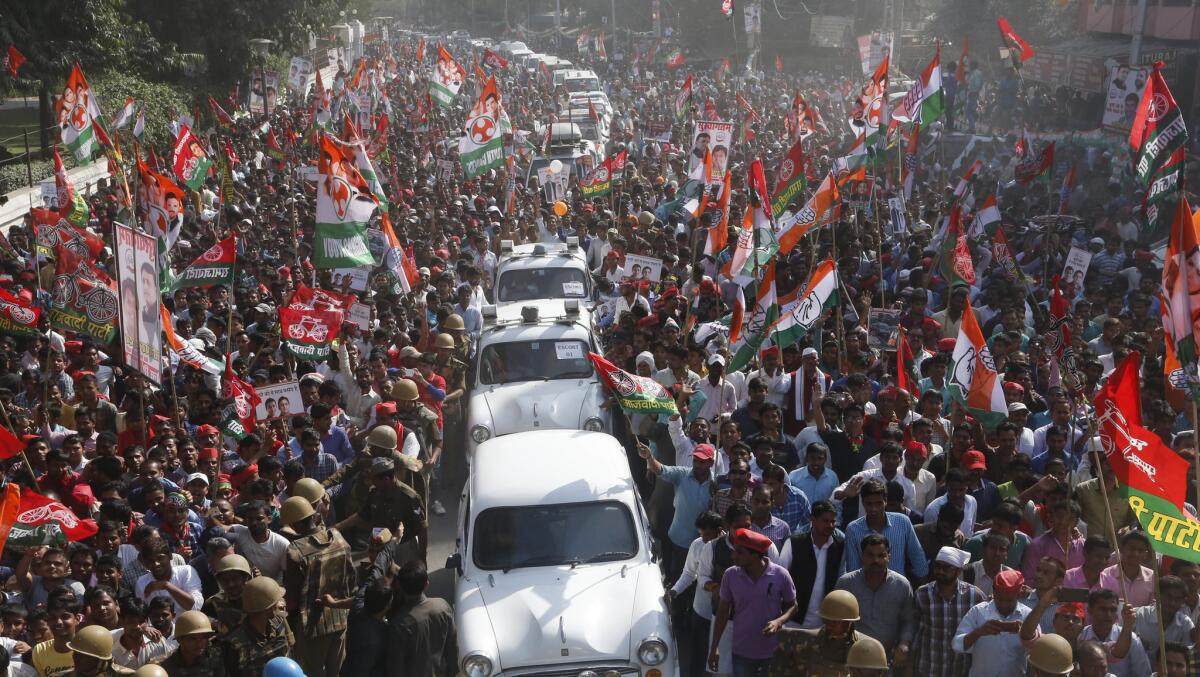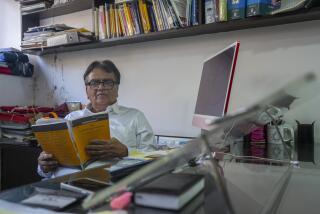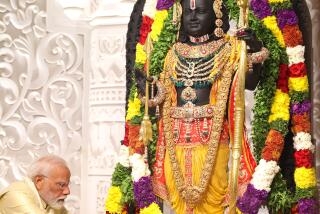Indian officials can no longer use flashing lights to skip traffic — but that’s only one sign of a ‘VIP culture’ run amok

- Share via
Reporting from Mumbai, India — They zip through toll plazas in dedicated lanes. They enjoy special access to tickets on overcrowded trains. And they’re notorious for showing up late to commercial flights, making regular passengers wait.
Being an Indian government official of even moderate standing carries seemingly endless perks and privileges. But no symbol of India’s “VIP culture” is as ubiquitous — or maddening — as the flashing red light.
Restricted in Western countries to police cars, fire engines and ambulances, the red beacons are a favorite bauble of Indian officialdom, used by dozens of categories of officeholders and dignitaries to bypass the country’s notorious traffic jams.
Soon, they’ll be stuck on the roads like everyone else.
Saying that “every Indian is a VIP,” Prime Minister Narendra Modi last week banned non-emergency vehicles from firing up the flashing lights, striking a blow against a feudal official culture in which India’s masses hew to countless rules while the powerful write their own.
“These symbols are out of touch with the spirit of new India,” Modi tweeted.
The lal batti, or red light, is an all-too-familiar irritation on the clogged roads of New Delhi or Mumbai, where motorists often find themselves stuck in neutral for no reason or ordered to pull over by a police officer for several minutes — only to see a shiny car whiz past with the flashing red, blue or amber light affixed to its roof.
A few state governments had already taken similar steps. The ban goes into effect nationally May 1 and applies to Modi himself, as well as top officials in his Cabinet and the heads of state governments. Law enforcement and emergency vehicles will still use them.
Current Indian government rules spell out more than 40 categories of dignitaries who are entitled to use different types and colors of beacons, from the president and prime minister down to state-level legislators and university vice chancellors.
From the archives: Special lights leave Russian drivers singing the blues »
Although meant to be used only in discharging government duties, the detachable lights have been spotted on the cars of officials’ relatives. In 2013, India’s Supreme Court — whose justices also were entitled to the beacons — complained that they were being given to “all and sundry” officials, even heads of village-level governments.
For Modi’s conservative government, which is cozy with big business and has loosened restrictions on corporate political donations, banning the lal batti was an easy populist move.
Praising the decision, the Indian Express newspaper described the red light as an “obscene” vestige of British rule that “perpetuated, in democratic India, the segregation of the ruler and the ruled, which was a hallmark of colonial power.” Several officials made a show of removing the lights from their cars after the government order.
But eliminating the beacons will not end a VIP culture that manifests itself in countless ways in a country of 1.3 billion people, where everyone is looking for a way to rise above the crowds, hassles and endless red tape.
Here are some of the more notorious episodes involving Indians trying to assert their privilege:
Politician slaps airline employee with slipper
Passengers on state-run Air India, which often carries government officials, regularly complain of VIPs behaving badly.
Last month, Ravindra Gaikwad, a legislator in Mumbai, assaulted an Air India employee for giving him an economy-class ticket on a two-hour commercial flight to New Delhi. (The aircraft did not have a business-class cabin.)
Gaikwad later boasted that he had slapped the employee with his slipper 25 times. Air India banned him from its aircraft for several days before the government ordered the company to allow him to fly again.
Politician’s entourage delays flight
In June 2015, an Air India flight from Mumbai to New York was delayed for more than 90 minutes, reportedly because a member of a government delegation forgot to bring his U.S. visa. Officials denied the mistake, blaming technical reasons for the delay.
Politician slaps metro passenger
In July 2015, M.K. Stalin, a politician in the southern city of Chennai, formerly Madras, marred the opening of a new metro line by slapping a passenger who refused to make way. As the video went viral, Stalin said the contact was “unintentional.”
Businessman exempt from airport security checks
Indian law allows more than 30 categories of VIPs to bypass preflight security checks at commercial airports. For years, those lucky dozens included a businessman whose main qualification was that he married into India’s most famous political family.
Robert Vadra, son-in-law of Congress party leader Sonia Gandhi, was the only person on the “no-frisk” list who was mentioned by name, which only made his inclusion all the more galling to most Indians. That changed in 2015, when Modi’s government amended the list and dropped Vadra — although he is still exempt when traveling with his wife, who is on a list of people granted special protection.
Motorcades move while ambulances wait
No one knows exactly how many ailing Indians have died because ambulances were stuck in traffic, but news media have documented several cases that resulted from VIP convoys blocking the roads.
In 2010, an 8-year-old boy died in the northern city of Kanpur after his parents could not take him to the hospital due to roadblocks put in place for a visit by then-Prime Minister Manmohan Singh. It was one of three deaths in a 13-month span blamed on road closures due to Singh’s motorcades.
This month in New Delhi, an ambulance carrying a wounded child was stuck behind a barricade for several minutes while a VIP convoy came through. An irate witness live-streamed the incident on Facebook; his video has been viewed more than 1 million times.
Cremation ground turns into parking lot
One day in September 2015, mourners in the northern city of Chandigarh who came to cremate their dead were told to wait. Modi was in town and the outdoor cremation ground had been converted into a temporary parking lot for his rally.
Residents protested after an official told them to put off the last rites “for a few hours,” until Modi had left town.
ALSO
India’s former ‘King of Good Times,’ beer baron Vijay Mallya, is arrested in London
As Trump threatens world climate pact, will India keep its promises to cut emissions?
Follow @SBengali on Twitter for more news from South Asia
Parth M.N. is a special correspondent.
More to Read
Sign up for Essential California
The most important California stories and recommendations in your inbox every morning.
You may occasionally receive promotional content from the Los Angeles Times.











